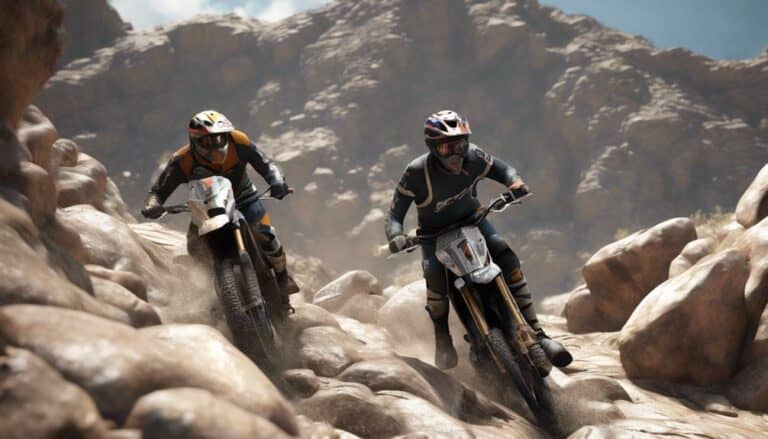Did you know that off-road riding accounts for over 90,000 injuries per year in the United States alone?
From unexpected obstacles to challenging terrains, off-road riding poses various risks that require careful consideration. Understanding these potential dangers and taking necessary precautions is essential to guarantee a safe and enjoyable experience.
So, what are some of the key risks you should be aware of, and how can you protect yourself while setting off on off-road adventures?
Stay tuned to discover essential insights that will help you navigate the thrill of off-road riding responsibly.
Key Takeaways
- Proper safety gear like helmets and gloves is crucial for minimizing injuries in off-road riding.
- Adapt riding techniques for different terrains to prevent accidents and ensure safety.
- Avoid excessive speeds to reduce the risk of rollovers, collisions, and loss of control.
- Emergency preparedness with essential supplies and knowledge of local services is vital for off-road adventures.
Common Risks in Off-Road Riding
Off-road riding presents a myriad of potential hazards, including rollovers, collisions, and loss of control on unstable terrain. When driving off-road, the rough terrain itself becomes a significant risk factor. Uneven surfaces, rocks, mud, and steep inclines all contribute to the dangers faced by off-road enthusiasts. These conditions can easily lead to accidents if not navigated carefully and responsibly.
Responsible off-roading involves understanding and respecting the challenges posed by the terrain. It's essential to equip yourself with the appropriate protective gear to mitigate the risks associated with off-road vehicles. Helmets, goggles, gloves, and sturdy clothing can make a critical difference in preventing or reducing injuries in case of accidents.
Importance of Proper Safety Gear
Proper safety gear plays a pivotal role in reducing the severity of injuries sustained during off-road riding incidents. When driving an off-road motorcycle, the terrain can be unpredictable, making safety features like helmets, goggles, gloves, and boots critical for your protection. Here is a breakdown of the importance of each protective gear:
| Gear | Importance |
|---|---|
| Helmet | Protects your head from impact injuries, reducing the risk of traumatic brain injuries during off-road accidents. |
| Goggles | Shield your eyes from debris, dust, and branches, ensuring clear vision while riding through challenging terrains. |
| Gloves | Provide grip on the handlebars, protecting your hands from blisters and abrasions, especially important for maintaining control. |
| Boots | Offer ankle support, shielding your feet and ankles from injuries, cuts, and fractures when traversing rough and uneven terrain. |
Investing in quality protective gear is essential for your safety while off-road riding, as it minimizes the impact of accidents and enhances your overall riding experience.
Precautions for Riding in Different Terrains
When maneuvering through various terrains while off-road riding, it's imperative to adapt your approach to guarantee safety and control in different environmental conditions.
Riding in off-road terrains like sand dunes requires caution due to the risk of loss of control.
Rocky trails pose potential hazards such as collisions and rollovers, emphasizing the need for slow and careful navigation.
To navigate mud and wet terrain safely, it's essential to employ proper off-road driving techniques to avoid getting stuck or sliding.
Snow-covered landscapes present challenges like reduced traction and visibility, necessitating specialized off-road vehicle handling skills.
When riding on unpaved dirt roads, be mindful of hidden obstacles or soft patches by scanning ahead and adjusting your speed accordingly.
Understanding the Risks of Speed
Exceeding safe speeds off-road greatly heightens the risk of accidents and jeopardizes control over your vehicle. Off-road environments are often unpredictable, with obstacles like rocks, tree roots, and sudden drops. When you speed through these terrains, you reduce the time you have to react to these challenges, increasing the likelihood of accidents.
Sand dunes, for example, can be treacherous at high speeds due to their constantly shifting nature. In addition, high speeds can lead to loss of control, rollovers, and collisions with obstacles, greatly amplifying the risk of injuries.
To mitigate these risks, it's important to understand the limits of your vehicle and adjust your speed accordingly. Remember that ground clearance, tire traction, and suspension play critical roles in off-road safety. Always wear a helmet to protect yourself in case of accidents involving off-road riding and consider hands-on safety training to enhance your skills and knowledge.
Emergency Preparedness for Off-Road Adventures
Exploring off-road environments successfully requires careful planning and preparation, especially when it comes to emergency readiness. To enhance your safety during off-road adventures and mitigate potential risks like wrongful death, it's important to prioritize emergency preparedness.
Carrying essential supplies such as water, a first aid kit, tools, and communication devices can be a lifesaver in emergencies. Knowing local rescue services and having trustworthy companions are essential aspects to think about. Understanding how to signal for help, navigate back to safety, and perform basic repairs are important skills that can make a significant difference in critical situations.
Identifying potential risks before setting out on your off-road journey is key to planning for emergencies effectively. Being prepared for unforeseen circumstances like getting stuck, lost, or encountering wildlife is crucial for your off-road safety. Remember, being proactive and well-equipped can mean the difference between a successful adventure and a disastrous outcome.
Conclusion
In summary, exploring the off-road terrain is like walking a tightrope without a safety net. It requires precision, skill, and constant vigilance to avoid potential pitfalls.
By equipping yourself with the right gear, knowledge, and mindset, you can conquer the challenges of off-road riding with confidence.
Remember, the thrill of the ride is worth the effort when you tread carefully and respect the wild landscape.

